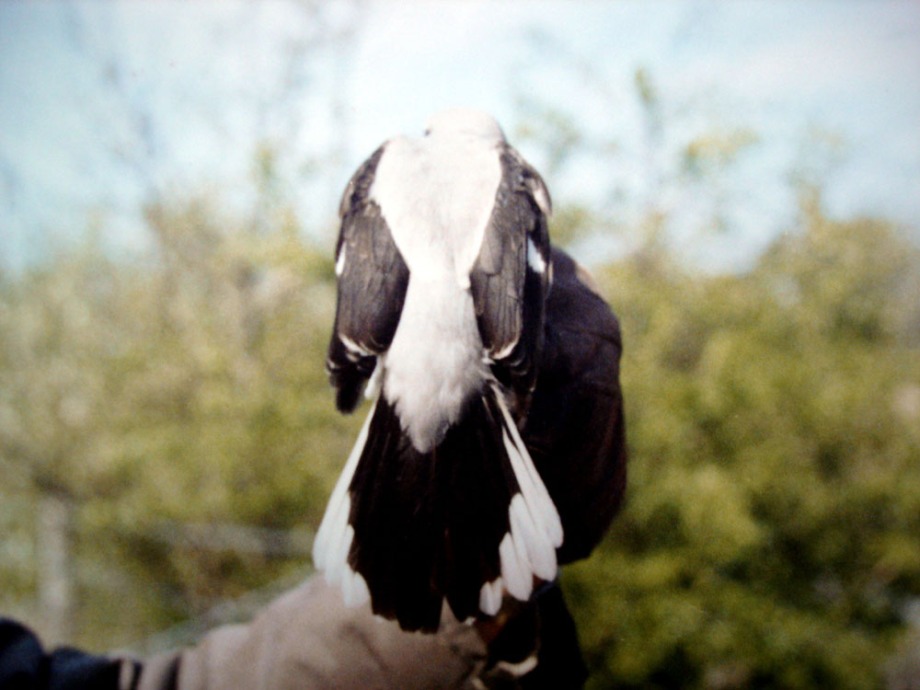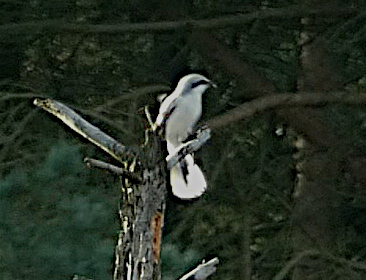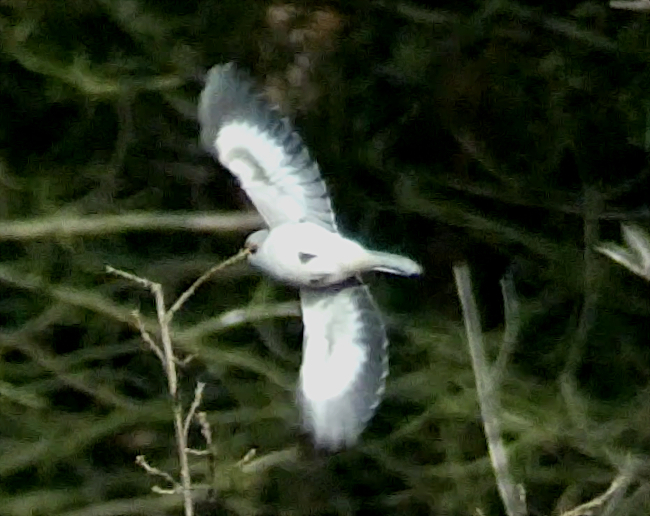In the most recent publication Svensson & Shirihai Great Grey Shrike is treated as having two races nominate excubitor in western Europe and homeyeri in the east. Further to the east homeyeri also has a variant (sometimes considered a separate race) named leucopterus, which apparently has even more white in the plumage than homeyeri. Within excubitor northern birds have a tendency to lack white in the secondaries (apparently not all birds) and these are often termed melanopterus. Birds from southern populations such as France and Germany and eastwards tend to have variable amounts of white in the secondaries (again apparently not all birds) and have been given the name galliae in the past. The amount of white in the wings and tails in these southern populations increases further east until it merges into homeyeri.
During the 2005/2006 winter a Great Grey Shrike was present in South Derbyshire at Walton-on-Trent. I eventually went to see this bird hoping to digiscope it, though when I arrived the bird had apparently made a foray over the border into Staffordshire. Later during the day I returned and the bird had reappeared in its usual area. Although it appeared quite elusive I managed to get some brief views and was intrigued by the overall pale appearance and the amount of white in the secondaries, though did not get any photos or good views of the tail. Checking the literature that evening it appeared that excubitor Great Greys could have some fairly extensive white there, so I left it at that until Martin Garner highlighted the possibility of a similar bird at Blacka Moor in South Yorkshire being of the race homeyeri on his blog. I went to see the Blacka Moor bird the following day. Again this bird appeared shy and elusive and I only got fairly distant views, before seeing it fly off over the border into Derbyshire, which unfortunately proved to be the final sighting of this bird. I read the following posts and the ongoing correspondence on Martin’s blog with some interest.
During the afternoon of 21st November 2020 I was walking around Farley with my wife Tracy. As we walked by an area of clear-fell a Great Grey Shrike flew up from the ground into a nearby tree. It was only present for a few seconds before it flew off, but it was immediately obvious that it had a lot of white in the secondaries, clearly it it was no ordinary excubitor or melanopterus type. My immediate impression was that it was more likely to be a galliae or homeyeri type and that it appeared very similar to the Blacka Moor bird. We relocated it several minutes later, moving around a fairly wide area, hunting from many of the pine stumps. We then returned to the car to pick up my camera and upon returning I took a few distant record shots, though it seemed quite wary, not allowing a close approach. At one point it caught a Meadow Pipit which it took to a nearby pine stump and skewered it onto a sharp point projecting from the top of the stump and began dismembering it, before suddenly carrying it off somewhere out of sight. That evening I put the news out on Twitter and decided to return for further views the following day.
Fortunately it was still present the following morning and Andy Butler and Ken Smith were already there and had obtained some good photos, better than any I managed to get. I watched it for several hours and managed to get some fairly distant pictures and video of it. The bird remained in this area, for several weeks but was elusive and erratic in its appearances. On 23rd January it was relocated at Bonsall Moor approximately 7.5 km SW of Farley.
I have used a few poor quality videograbs in this post. Andy’s (better) photos can be viewed on his blog at Wildlife Diaries (andybutlerdiaries.blogspot.com) and also at Darley Dale Wildlife
It’s size and shape was that of a typical Great Grey Shrike, but the plumage differed in the following ways. The most obvious feature was the large rectangular white at the base of the secondaries, about equal in size to the pale patch at the base of the primaries which itself appeared longer than on a typical excubitor. This latter patch was longer towards the inner primaries extending about half the length of the innermost primaries. At least the outer four or five secondaries also had extensive white at the base broadening towards the outermost, the white covering somewhere between a third and half of the base of the outermost. Together these formed a strikingly large area of white in flight views. All the secondaries also had white tips broadening inwards. The tertials also formed a large white arc on the closed wing, larger and more obvious than on a typical excubitor. Most of the upperparts including the crown appeared a paler shade of grey than on a typical excubitor, while the uppertail coverts appeared to be white shading into a largely white rump. This last feature varied with the light conditions but the whole rump area often appeared obviously contrastingly whitish in the field. The lower rows of scapulars appeared very pale whitish and more extensive than, but perhaps more diffuse and not contrasting as much with the paler grey upperparts compared to an excubitor. The tail also had more white than a typical excubitor, with the outermost (T6) appearing completely white, the next innermost (T5) appeared mostly white, but I think I could detect an area of black towards the base of the inner web reaching the shaft, this was very difficult to be certain in the field but appears to be confirmed by one of Andy’s photos. This appears limited to an area a short way from the base, the base of the feather being white. The exact extent of this black was difficult to see due to the overlap of T4. The white at the base of the tail feathers gave the black area of the tail more of a diamond shape. It also had a fairly prominent supercilium, more extensive than a typical excubitor which extended over the forehead and appeared slightly broader behind the eye. Again this usually appeared quite diffuse due to less contrast with the paler crown and varied with lighting conditions. The underparts appeared plain off-white and appeared to lack any barring. The bill appeared mainly dark with a paler area at the base of the lower mandible possibly extending slightly onto the upper mandible. The legs and feet appeared a darkish grey.

In his Challenge Series Winter Martin proposed a list of potential features to identify homeyeri (in bold below) which I have compared this bird with.
1 Upperparts pale grey;- this bird certainly appeared quite pale and fits the bill there.
2 Underparts ash-grey or white usually without a pattern;- Again this bird with its off-white un-patterned underparts seems to fit this ok.
3 Scapulars white;- The scapulars on this bird appeared to be mainly white diffusely grading into the pale grey mantle and seemed ok.
4 Maximum length of white primary patch 68.3-76.9mm;- Not really possible to measure this but certainly seemed considerably longer than on a normal excubitor.
5 White secondary patch large 51.8-70.8mm often with obvious bleeding of white along secondary fringes connecting with white at the base of the secondaries with the tips;- Again this appeared large but I did not notice any white bleeding along the fringes of the secondaries though the statement “often with” presumably means not always. I suspect this is more of a regular feature of leucopterus and I wonder if it might be more of a feature associated with leucopterus intergrades?
6 Tail feathers All white outer tail feather. Some have all white T5 or with some black. Two all-white outer tail feathers is typical;- This bird did appear to have some black on T5, difficult to asses how extensive due to the overlap of T4. Maybe still ok but perhaps too extensive?
It has also been suggested on several posts I have read online that there should not really be a step between a shorter area of white on the secondaries compared to the adjacent primaries, but photos of homeyeri from Kazakhstan for example do show a similar step. I have found that the amount of white visible in the secondaries on the open wing is dependant upon how wide the wing is stretched open, due to the mechanics of how a birds wing closes. On this bird for example I noticed that when the wing was only partially open the amount of white in the secondaries appeared relatively small and there was a noticeable step compared to the primaries, but when the wing was fully stretched open this step virtually disappeared. As soon as the wing begins to bend the secondaries appeared to quickly disappear under the coverts about twice as fast as the outer wing bends inwards. This is well worth bearing in mind when viewing photographs of Shrikes in order to try to and assess this feature.
So what do I think the Farley bird is? Well overall I think the bird was clearly from somewhere well to the east along the cline between excubitor/galliae types and homeyeri types, but exactly where is impossible to say and whether it could be assigned to homeyeri seems to me to be a bit of an arbitrary decision as there still appears to be some uncertainty over what exactly defines whether a bird is an excubitor (galliae) or a homeyeri. Shirihai and Svensson appear to only reluctantly consider homeyeri to be separate from excubitor because the extreme ends of the cline are quite different. Actually leucopterus would be at the extreme end of the cline but they consider this to be a variant, presumably as it is insufficiently and inconsistently different from homeyeri which was named first, and so it is included within that race. Moreover individuals showing characteristics of leucopterus can apparently be found throughout the range of homeyeri and it seems likely that birds showing excubitor intergrade characteristics could also be found within the core range of homeyeri. As for the Farley bird there appears to be nothing to rule out homeyeri in the main identification guides, though the Scandinavian countries appear to be now only accepting birds with extreme leucopterus type features and some previously accepted records are now considered unacceptable or considered to be intergrades. Whether or not this is the right approach is questionable, as it would leave most birds from the core range of homeyeri unidentifiable in a Western European context. The Farley bird certainly has many features that appear to be more consistent with homeyeri but based on the Scandinavian approach the amount of black on T5 might perhaps suggest it to be an intergrade. Similar birds seem to be not that rare, with reports from Fakenham Norfolk, Sutton in Suffolk, the Forest of Dean as well as the Blacka Moor bird to name but a few, so birds from these regions are clearly arriving in the U.K. with some regularity, although only excubitor is on the British list. Hopefully this bird will add to the dataset and together with previous and future records help to clarify the status of homeyeri in the U.K.
So personally at present I feel at present it is probably best to leave the Farley bird unassigned pending further clarification. The most important thing for me is the knowledge that this bird has come from some way to the east as opposed to the more usual northern origin of most birds that arrive in the U.K. As always I would welcome any comments.
Below are a selection of videograbs of the bird.





On a more general note I get the impression that in good Shrike years when birds are more numerous melanopterus types usually predominate, whereas in years when birds are more scarce excubitor/galliae types seem more frequent. I also find that some melanopterus types can sometimes be quite confiding perhaps due to birds having less contact with humans, a bit like some arctic waders, while I find the birds from the more southern populations are usually less tolerant, perhaps due to them originating from areas where they have more contact with a denser human population.


